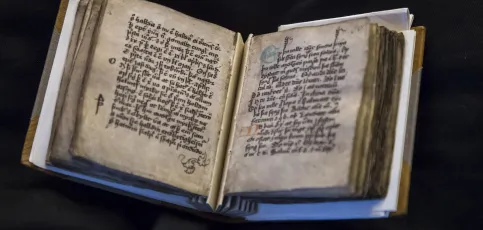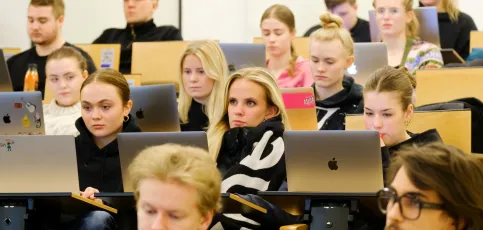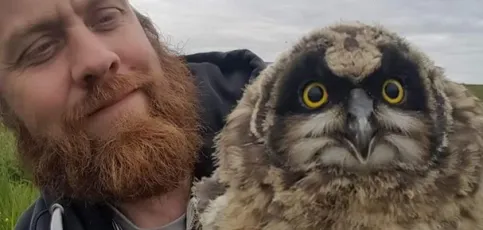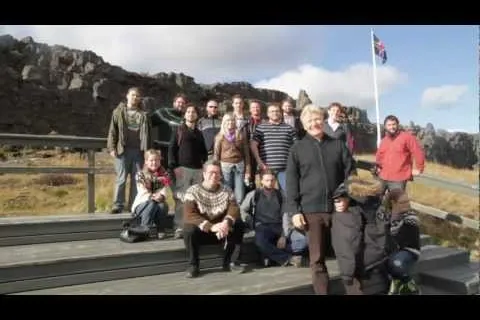
This international two-year Nordic Master’s Program offers an interdisciplinary approach to Viking and Medieval Scandinavia by drawing on expertise in the fields of Norse literature, including the Eddas and sagas, linguistics, history, textual criticism, palaeography, runology, folklore, religion, art and archaeology at four different Nordic universities:
- Aarhus University, Denmark
- University of Copenhagen, Denmark
- University of Oslo, Norway
Associated research institutes.
- Árni Magnússon Institute for Icelandic Studies in Iceland
- Arnamagnæan Institute at the University of Copenhagen
The institutes share custody of the largest single collection of Icelandic medieval manuscripts in the world.
The Árni Magnússon Collection was inscribed on the UNESCO Memory of the World Register in 2009.
Application deadline for the programme is 1 February.
The Viking and Medieval Norse Studies programme welcomes qualified students with different academic backgrounds from all over the world.
Our current and former students form a diverse and international group of talented people from countries including Brazil, Bulgaria, Canada, China, Columbia, Czech Republic, Finland, France, Germany, Hungary, Japan, Israel, Lebanon, the Netherlands, Norway, Ukraine, Poland, Puerto Rico, Russia, Slovenia, Spain, Switzerland, the United States, and the United Kingdom.
Students with university degrees in, for instance, Anglo-Saxon, Norse and Celtic, anthropology, archaeology, art history, comparative literature, English, English literature, classics, German, German literature, history, ancient history, medieval history, medieval studies, music history, philosophy, religious studies, Scandinavian languages, Scandinavian literature, or Scandinavian studies.
Prior knowledge of Old Icelandic/Old Norse is not required, but special emphasis is placed on developing skills in Old Icelandic in the first year through courses at introductory and intermediate levels.
The language of instruction is English.
Viking and Medieval Norse Studies is an international two-year graduate programme, with 120 ECTS credits. Leading to a master's degree.
The first two semesters take place at the University of Iceland in Reykjavík. In the third semester, the students can choose between courses at:
- Aarhus University, Denmark
- University of Copenhagen, Denmark
- University of Oslo, Norway
The fourth and final semester is reserved for writing a master’s thesis at the University of Iceland or the University of Oslo.
| Semester | University | ECTS |
|---|---|---|
| First semester - Autumn | University of Iceland | Coursework: 30 ECTS |
| Second semester - Spring | University of Iceland | Coursework: 30 ECTS |
| Third semester - Autumn |
Aarhus University or |
Coursework: 30 ECTS |
| Fourth semester - Spring |
University of Iceland or |
Master's thesis: 30 ETS |
Full-time studies for one academic year count as 60 ECTS credits, 30 ECTS credits each semester. At the University of Iceland School of Humanities, a typical course is 10 ECTS credits.
The study tracks 1 and 2 lead to a joint degree from the University of Iceland and University of Oslo.
The study tracks 3 and 4 lead to a degree from the University of Iceland with a diploma supplement from Aarhus University or the University of Copenhagen.
Faculty members from Aarhus, Copenhagen and Oslo will be visiting Reykjavík in the 1st semester to present the course offerings in the 3rd semester, to the extent the course offerings have been decided, and participate in seminars.
The deadline for choosing a study track is January 31.
There is a limited number of seats at each of the three partner universities; this is especially true with the thesis supervision in the 4th semester. Consequently, it cannot be guaranteed that everyone gets his or her first-choice placement in the 3rd and 4th semesters.
- Semester 1: University of Iceland — 30 ECTS coursework
- Semester 2: University of Iceland — 30 ECTS coursework
- Semester 3: University of Oslo — 30 ECTS coursework
- Semester 4: University of Oslo — 30 ECTS master’s thesis
- Semester 1: University of Iceland — 30 ECTS coursework
- Semester 2: University of Iceland — 30 ECTS coursework
- Semester 3: University of Oslo — 30 ECTS coursework
- Semester 4: University of Iceland — 30 ECTS master’s thesis
- Semester 1: University of Iceland — 30 ECTS coursework
- Semester 2: University of Iceland — 30 ECTS coursework
- Semester 3: Aarhus University — 30 ECTS coursework
- Semester 4: University of Iceland — 30 ECTS master’s thesis
- Semester 1: University of Iceland — 30 ECTS coursework
- Semester 2: University of Iceland — 30 ECTS coursework
- Semester 3: University of Copenhagen — 30 ECTS coursework
- Semester 4: University of Iceland — 30 ECTS master’s thesis
As already indicated, the 4th semester or the thesis semester can only take place at the University of Iceland or the University of Oslo.
The student shows in his master’s thesis that he/she/they can independently perform quality research on an academically important subject. The student has developed the ability to work independently and is prepared to write research papers on subjects in the area of medieval studies, on his own or with others.
A master’s thesis submitted to the University of Iceland should be approximately 50 pages, 20,000 words (about 400 words per page), inclusive of text, but exclusive of references, endnotes, appendices, and bibliography.
The Scandinavian Department, in collaboration with the Departments of Religion, History and Archaeology, offers wide-ranging expertise in many of the subject areas covered by the programme.
Aarhus University promotes a vibrant interdisciplinary milieu, and scholars in the various departments are keen to work with international students, both as teachers and course coordinators. Aarhus University offers special expertise in the fields of literary analysis, literary and cultural theory (narrativity, memory studies, orality and literacy), reception studies, Old Norse mythology, comparative religion and anthropological theory, and material history.
The Viking and Medieval Norse Studies programme is represented at Aarhus University by:
Pernille Hermann Associate Professor.
Department of Aesthetics and Communication — Scandinavian
Email: norph@cc.au.dk
Course offerings vary from one year to another. These are some of the courses that have been offered in recent years:
Saga Literature and Concepts of Memory (10 ECTS).
Instructor: Prof. Pernille Hermann
In recent decades there has been an increased focus on memory studies in the humanities. This course will deal with recently developed theories of memory and investigate them specifically in relation to the medieval Icelandic saga, a genre which is immensely preoccupied with the past, i.e. the Viking Age. Medieval culture was a memorial culture, which makes it highly relevant to investigate how the people behind the literature of that time trained their memory and in what ways the literature was indebted to different types of memory. During the course, various memory types will be presented and discussed, for instance, collective memory, cultural memory and individual memory, and it will be asked to what extent theories of memory can increase our understanding of the sagas. Also, medieval perceptions of memory will be explored, for instance, through investigations of how memory was expressed (metaphorically or directly) in the texts. It is the main purpose of this course to investigate how various branches of (relatively) newly developed memory studies can offer a useful framework for understanding the past that is described in the medieval Icelandic saga. The course will provide the students with knowledge of theoretical aspects of general relevance for how groups and individuals of all times approach their past, as well as with a new perspective on a unique genre which until this day has puzzled its readers. Students will be expected to participate actively in class (i.e. with oral presentations and in group work) and to identify relevant fields of research. Exam: According to the study regulations, written essay if more than 10–12 students, oral exam if less than 10 students.
The Rhetorics of Old Norse Mythology (10 ECTS).
Instructor: Rolf Stavnem, Ph.D.
Old Norse Mythology is primarily preserved for posterity in poems and prose narratives that are redacted or summarised by medieval scribes. Most of the extant narratives are found in the two Eddas, The Poetic Edda and Snorri's Edda. A thorough study of these two medieval books is the foundation for the study of Old Norse mythology. Both works are celebrated classics in Scandinavian literature and although they have been studied by generations of scholars from various disciplines the interest in them has not diminished the slightest and many central questions remain to be solved. In the course, we will explore myths and mythic references in the Eddas on three different levels:
- The genre in which mythology is represented, namely skaldic poetry, Eddic poetry, prose narrative and didactic prose. Most clearly the role of generic conventions is seen in cases where myths are known from more than one type of narration and consequently differ significantly from genre to genre. Archetypical forms of narration such as myth, fairy tale and riddles will be considered as well as theories on orality and literacy will be important points of reference for the discussion.
- The worldview represented in the texts reflects both a religious and a secular approach to daily life including views on women and men, sexuality, honour, death etc.
- The medieval Christian textual culture in which myth was transmitted and interpreted. The intellectual elite of Iceland edited and contextualised the vast material in fictionalised frame narratives and learned speculation to fit Old Norse myth into a Christian worldview. The fundamental question yet to be solved is the degree of the Christian impact on the traditional pre-Christian material and how much it means for our understanding of it.
Problems and Strategies in the Reconstruction of Pre-Christian Scandinavian Religion (10 ECTS).
Instructor: Prof. Jens Peter Schjødt
In attempting to reconstruct the pre-Christian religion of the North we face a host of problems; most of them have to do with the sources. As everybody the least acquainted with the subject will know, most of the sources are written in the Middle Ages and it is very difficult to judge how much the authors knew about the pagan past. Further, we also know that what has been transmitted in the extant manuscripts is only a tiny bit of what once existed in the lore of pre-Christian Scandinavia, most often in oral form. These problems and many more make it extremely difficult to do any sort of reconstruction.
What we shall deal with in this course is thus firstly to identify the problems that are at stake and secondly to discuss what means we do have, nevertheless, in our attempts of such reconstructions, evaluating the approaches of various disciplines. New recognitions within the history of religions seem to be of help, not least when it comes to the use of comparative material. Using such comparative material will offer opportunities for asking more qualified questions about the material than was done earlier on.
The course will be a mixture of lectures and discussions of individual sources as well as theoretical problems concerning historical reconstructions, for instance, the value of ordinary source criticism, applied to reconstructions of no-longer existing religions. The students will be asked to identify specific areas of problems and to give oral as well as written presentations. Some weeks there will thus be individual supervision rather than ordinary teaching. During the first couple of weeks, we will therefore decide the details of the program which will depend on the individual needs of the students (exam: written essay).
Other courses offered in recent years include:
- Old Norse-Icelandic literature (Scandinavian Institute) (10 ECTS)
- Old Norse Myths in Eddas and Sagas (Scandinavian Institute) (10 ECTS)
- Old Norse Myth in Medieval and Modern Times (Scandinavian Institute) (10 ECTS)
- Old Norse Religion (Scandinavian Institute) (10 ECTS)
- History and Cultural Memory (Department of History) (10 ECTS)
The Department of Scandinavian Research offers wide-ranging expertise in the many subject areas covered by the programme, including Old Danish and Old Swedish.
The Arnamagnæan Institute houses half of the Arnamagnæan manuscript collection and also has an excellent research library. The Institute staff will provide advice and training for students, especially in the fields of manuscript studies and artefactual philology, textual criticism and scholarly editing, and textual and literary history.
The Name Research section offers expertise in onomastics, runology and Anglo-Norse studies. The Arnamagnæan Institute also hosts the Dictionary of Old Norse Prose project, whose resources will be available to students.
The Viking and Medieval Norse Studies programme is represented at the University of Copenhagen by:
Anne Mette Hansen, Associate Professor
Department of Nordic Research
Email: amh@hum.ku.dk
Course offerings vary from one year to another. These are some of the courses that have been offered in recent years:
East Norse. Texts and artefacts (15 ECTS).
Instructors: Anne Mette Hansen, Michael Lerche Nielsen, Rikke Steenholt Olesen, Guus Kroonen, Beeke Stegmann
This course is an introduction to runic and medieval East Norse language and literature. The course offers a chance to study East Norse texts in the original language, reading a range of Old Swedish and Old Danish texts representing Scandinavian genres as well as rewritings and adaptations of European works, such as inscriptions on stones and loose objects, provincial laws, chronicles, anthologies of instructional texts, legends and devotional books. The course presents an overview of the history of the East Norse languages from the Iron Age to the Late Middle Ages dealing with the following topics: the linguistic developments from Proto-Norse to East Scandinavia, the emergence of East Scandinavian runic dialects, the runic lexicon, a description of the morphology and syntax of Old Swedish (c. 1225 – 1526) and Old Danish (c. 1100 – c. 1525). The course includes field trips to runic locations in Denmark and Southern Sweden. As the majority of the texts to be read are preserved in manuscripts located in the Arnamagnæan Collection in Copenhagen students will get hands-on practice in reading, examining and describing manuscripts. Participants (who need no prior experience with East Norse) will learn to read the runic alphabet and how to transliterate runic inscriptions. They will learn how to read and translate diplomatic (un-normalized) representations of texts in East Norse and will be able to identify Old Swedish and Old Danish texts respectively and to characterize the texts as regards syntax and style. They will get an overview of the usage of runes from the Iron Age to the High Middle Ages in Southern Scandinavia and of East Norse texts and manuscripts. They will gain basic knowledge of East Norse palaeography and the codicology of the medieval book.
The Icelandic fornaldarsögur and early historiography: origin, transmission, reception (15 ECTS).
Instructors: Annette Lassen, Tereza Lansing, Gottskálk Jensson, Beeke Stegmann
The group of Icelandic sagas known as fornaldarsögur Norðurlanda, literally ‘Stories of the northern lands in ancient times’, deal with the kings and heroes of mainland Scandinavia before the settlement of Iceland in the 9th century. Although they date, in their present form, predominantly from the 14th and 15th centuries, and are thus younger than the ‘classical’ Icelandic family sagas, most have at least some basis in significantly older tradition, and many of the characters and events depicted in them are found also in other sources, both in Old Norse and other languages. Saxo Grammaticus used them – or something like them – as a source for his Gesta Danorum, written in the 13th century, and many have echoes in the Scandinavian ballad tradition. The fornaldarsögur were among the most popular of saga genres, and are preserved in hundreds of manuscripts, the majority post-medieval paper manuscripts, some from as late as the early 20th century. Most are also found in metrical versions known as rímur, some from the Middle Ages, but the bulk from the 18th and 19th centuries. The fornaldarsögur were also among the earliest saga texts to be printed and translated (in the 17th and 18th centuries into Latin and Swedish, in the 19th into Danish, German and English), and they were also a source of inspiration for poets, writers and artists throughout northern Europe, e.g. Tegnér and Wagner.
The course will analyse this material, starting with Saxo and working through the fornaldarasögur themselves, employing methods deriving not only from traditional textual and literary criticism but also newer areas such as material philology and the history of transmission.
Other courses offered in recent years include:
- The Nordic Languages in the Medieval Period (15 ECTS)
- Old Icelandic (15 ECTS)
- Old Swedish and Danish (15 ECTS)
- Old-Norse-Icelandic Literature and Culture (15 ECTS)
- Applied linguistic data for cultural history (15 ECTS)
- Primary sources and philological methodology (15 ECTS)
- History of Scandinavian philology (15 ECTS)
- Scandinavian Manuscript Studies (7.5 ECTS)
- Runology (15 ECTS)
- Onomastics (15 ECTS)
The Department of Linguistics and Scandinavian Studies at the University of Oslo offers wide-ranging expertise in many aspects of the programme. Its particular strengths lie in philology, poetics and medieval grammatical literature, runology, medieval literacy, palaeography and codicology (material philology), Viking age archaeology, medieval art (book illumination, ecclesiastical art), and Anglo-Norse and Celtic-Norse relations.
The Viking and Medieval Norse Studies programme is represented at the University of Oslo by:
Karl-Gunnar Johansson, Professor
Department of Linguistics and Scandinavian Studies
Email: k.g.a.johansson@iln.uio.no
Course offerings vary from one year to another. These are some of the courses that have been offered in recent years:
NFI4100— Runology – general introduction (10 ECTS)
Runology is concerned with some 1300 years of history of writing. Runes constituted the script used by many Germanic peoples from the second century A.D. Their use died out in Norway around 1400. This course spans the entire history of runes and gives an overview of both the secondary literature and the inscriptions themselves. There will be a special focus on how to deal with the interplay between data (the runes) and theory (about the development of writing).
NFI4112 — Old Norse Rhetoric and Poetics in a European Context (10 ECTS)
An introduction to Old Norse rhetorics and poetics – grammatica – in Iceland between c. 1150 to 1400. The course will also provide a European background for the medieval study of grammatical as well as rhetorical and poetical praxis. The European tradition will be studied in translations from Latin sources. A major focus will be on the relation between the introduction of European traditions and the Old Norse poetical traditions.
KUN4305E — Inside the medieval church: the church room and its decoration in medieval Scandinavia (10 ECTS)
The course will deal with various aspects of church interiors in Scandinavia in the Middle Ages. Issues that will be covered are the spatial organization of the church room as a setting for the liturgy, as exemplified in the various types of churches that were raised during the Middle Ages; the history of decoration of the church interior – materials and motives from the 12th to the 15th century; iconographical case studies, focusing on the multiple dimensions of meaning of medieval church art. An underlying perspective will consist of a historiographical survey of the development of art historical scholarship on the art of the Scandinavian Middle Ages and a consideration of its theoretical and methodological foundations.
HIS4133 — The Cult of Saints in Norway and Iceland, c. 950-1250 (10 ECTS)
The cult of saints was a central part of the Christian faith in the Middle Ages. It became an important part of conversion and arguably the single most important aspect of Christianity for common people, with saints able to intercede and protect people through miracles in a way that the Norse gods could not. By dying the saints were thought to reach a place of vicinity to God and were therefore in a favorable position for interceding with God on behalf of the living. Thus one thought that the saints were functioning as intermediary links between God and the humans and that they especially could be turned to in suffering and need.
The saints and their relics were to be treated respectfully. If one failed to do so the wrath of the saints could be cast upon you. On the other hand, the saints had to prove to be worthy of being invoked. If some saints seemed to be less powerful than others, one would stop praying to the former. The saints therefore had to constantly prove their powerfulness or risk that their cult disappeared. As a result, the cult of saints was constantly changing.
These are amongst the aspects of the cult of saints in Norway and Iceland that this course will address. In addition, we will also compare the development of the cult of saints in Norway and Iceland to other parts of Western Europe.
ENG4154 — Old English, Introduction (10 ECTS)
Ann introduction to English as it was before the Norman Conquest (1066), that is, to one of the early Germanic languages. For the first half of the semester, students will work through Duncan Macrae-Gibson's "Learning Old English" (an interactive audio course, with written exercises to be discussed in class). This provides a step-by-step guide through the grammar set out in Sweet's "Anglo-Saxon Primer". The second half of the semester will be devoted to a study of texts in Sweet's "Primer", nos. I, IV, V, VI, and VIIb. These will afford some insight into the literature and history of England at a time with variously close links with Scandinavia. You will gain insight into the contents mentioned above in a manner to ensures your ability to perform simple analyses of Old English texts. Further, the course will lay the ground for studies of Old English at MA level.
FIL4560 — History of philosophy from 600 BC until the 17th century (10 ECTS)
The topics of the course are works/epochs/schools/ideas in the history of philosophy from around 600 BC until the Renaissance. Texts and focus may vary, but important names will be Heraklit, Parmenides, Socrates, Platon, Aristoteles, Hellenistic philosophers, neo-platonists, Augustin, Boethius, Thomas Aquinas, Ockham, Montaigne and Galileo. The aim is to give the participants an in-depth understanding of philosophical problems from this period and to show their relevance for later discussions.
Other courses offered in recent years include:
ENG4160 — Language and Settlement in Britain, ca. 200-1000 A.D (10 ECTS)
An introductory course which examines the various colonisations of that part of Britain which became England, from the late Romano-British period into the Anglo-Norman era; the story is dominated by the Anglo-Saxon and Norse settlements, and the Norman Conquest, but Frisian and Flemish also enter the narrative, which will of necessity consider other parts of the British Isles. The course will examine texts, the evidence of place names, and to some extent archaeological evidence; source criticism will be an important part of the survey.
HIS4140 — Objects and Identities in the Viking Age (c. 750—c. 1050) (10 ECTS)
This interdisciplinary course deals with the social history of the Viking Age, with an emphasis on mainland Scandinavia and its interactions with neighbouring countries from c. 750 to c. 1050. In this period, Scandinavia was characterized by a high degree of social mobility and profound socio-political changes. The Scandinavian emigration of the ninth and tenth centuries left noticeable imprints on adjacent regions such as Carolingian Francia, Anglo-Saxon England, the North Atlantic and Eastern Europe. The political and religious impacts of Ottonian Germany, Anglo-Saxon England, early Rus’ and Byzantium on tenth- and eleventh-century Scandinavia were equally important. The first part of the course will provide a general introduction to the historical period. In the second part of the course, the traditional social categories of identity (ethnicity, religion, social status, and gender) will be applied to the world of multiple identities in Viking Age Scandinavia. The final part of the course will be focused on several material objects that functioned as important symbolic markers of identities and will exemplify the use of material evidence in Viking Age studies.
KUN4306E — Art and visual culture of the later Middle Ages (10 ECTS)
In the course, the art of the later Middle Ages from c. 1300 to the 1530s will be studied from a perspective where the artworks are seen as manifestations of the visual culture of the period. Rather than approaching them as works of art in the conventional sense, the course will focus on the manner in which the objects have made sense to their original beholders by virtue of the visual and material qualities that constitute their essential characteristics. Medieval theories of vision, visuality and materiality will be reviewed, and the perception, reception and use of images in various cultic settings as well as in secular contexts, will be studied.
Also:
- Old Norse — language and texts (10 ECTS)
- Old Norse Paleography, Codicology and Medieval Manuscript Culture (10 ECTS)
- England’s Viking Inheritance (10 ECTS)
- Language and Settlement in England, ca. 400–1200 A.D. (10 ECTS)
- The Poetic Edda — from Orality to Literacy (10 ECTS)
University of Iceland
Haraldur Bernharðsson, Associate Professor, email: haraldr@hi.is
Aarhus University
Pernille Hermann Associate Professor, email: norph@cc.au.dk
University of Copenhagen
Anne Mette Hansen Associate Professor, email: amh@hum.ku.dk
University of Oslo
Mikael Males Associate Professor, email: mikael.males@iln.uio.no
Excursions to the saga trails are an important part of the program. In a typical year, we organize three to four day-long trips (usually on a Saturday) and one shorter trip (half a day); dates vary from one year to the next.
We rent a bus and split the cost, usually no more than EUR 55 / USD 60 (often less) per person. Significant others, friends, and exchange students are all welcome to join. Below are some of the most regular excursions.
Afternoon trip, 2 pm to 8 pm.
Map with an itinerary and some notable places.
We will drive through Mosfellsdalur valley where Egill Skallagrímsson spent his last years and hid his two chests of silver. At Þingvellir, we will walk down Almannagjá gorge, to Lǫgberg, across Øxará river and the Þingvellir fields. Then we will drive south along the eastern side of Lake Þingvallavatn to Selfoss where we will make a rest stop (Selfoss food hall) before heading back to Reykjavík.
Full-day excursion: 8 am to 8 pm.
Map with an itinerary and some notable places.
This (long) full-day excursion features some of the sites of Egils saga Skallagrímssonar and Gunnlaugs saga ormstungu, as well as some important places in the life of Snorri Sturluson and his family, including:
- Brákarsund (Egil saga) — Skallagrímshaugr (Skallagrímr’s burial mound, Egils saga)
- Borg (Skallagrímr & Egill, Þorsteinn Egilsson & Helga fagra, Snorri Sturluson, etc.)
- Grábrók crater (weather permitting)
- Stafaholt (Óláfr Þórðarson hvítaskáld)
- Háafell goat farm (the Icelandic breed of goats, including a four-legged Game of Thrones actor)
- Gilsbakki (Gunnlaugr ormstunga)
- Hallmundarhraun lava field (10th century, Hallmundr the giant, Hallmundarkviða poem),
- Hraunfossar & Barnafoss waterfalls
- Reykjaholt (Snorri Sturluson and his pool)
- Hverinn (watering hole, not in any of the sagas)
Full-day excursion: 8 am to 8 pm.
This (long) full-day excursion features some of the sites of Brennu-Njáls saga and outstanding places in medieval Icelandic history. These include:
- Skálaholt, the seat of the historical southern episcopal see
- Keldur á Rangárvǫllum (Ingjaldr; a monastery founded by Jón Loftsson?)
- Knafahólar/ Gunnarssteinn (where Gunnarr, Kolskeggr, and Hjǫrtr were ambushed)
- Hof á Rangárvǫllum (Valgarðr grái)
- Grjótá (Þráinn Sigfússon)
- Hlíðarendi í Fljótshlíð (Gunnarr)
- Rauðaskriður (Njál‘s sons ambush Þráinn Sigfússon and company)
- Ossabœr (Hǫskuldr Hvítanessgoði)
- Bergþórshváll (Njál and Bergþóra)
- Oddi á Rangárvǫllum (Sæmundr fróði Sigfússon, Jón Loftsson).
Full-day excursion: 8 am to 9 pm.
Map with an itinerary and some notable places.
In this (long) full-day excursion we will visit some of the sites in Laxdœla saga and the first part of Eiríks saga rauða, including:
- Eiríksstaðir, Eríkr rauði’s place,
- Vínlandssetur Leifsbúð exhibition on the Vínland expeditions in Búðardalur;
- Hrútsstaðir (Hrútr Herjólfsson),
- Höskuldsstaðir (Hǫskuldr Dala-Kollsson, Hallgerðr Hǫskuldsdóttir),
- Goddastaðir & Hjarðarholt & Melkorkustaðir? (Óláfr pái, Jórunn, Melkorka, Kjartan & Bolli),
- Laugar í Sælingsdal (Guðrún Ósvífrsdóttir and the pool),
- Tunga (Guðrún & Bolli; Snorri goði),
- Hafragil (Kjartan ambushed),
- Hóll (“Bróka”-Auðr; later Sturla Þórðarson),
- Magnús í Tjaldanesi,
- Skarð (Skarðverjar, Skarðsbók Jónsbókar, Skarðsbók postulasagna),
- Geirmundarstaðir (Geirmundr heljarskinn),
- Klofningr,
- Fell (Þorvaldr Ósvífrsson, Hallgerðr langbrók’s first husband),
- Hvammr & Krosshólar (Unnr/Auðr djúpúðga; Hvamm-Sturla, Snorri Sturluson; Árni Magnússon).
Full-day excursion: 8 am to 9 pm.
This (long) full-day excursion will focus on the Eyrbyggja saga trails along with some other notable places including:
- Álftafjǫrðr — Þórsnes,
- Hofstaðir (Þórólfr Mostrarskegg and his Þórshof),
- Þingvǫllr assembly place (and the Þórssteinn sacrificial stone),
- Helgafell (Snorri goði, Guðrún Ósvífrsdóttir)
- Berserkjagata trail in Berserkjahraun lava (the trail through the lava cleared by the berserks; the wall erected by the berserks; the berserks‘ burial mound)
- Bjarnarhöfn (Bjǫrn austrœni, Vermundr mjóvi) and Bjarnarhöfn Shark Museum (with tasting!)
- Kirkjufell mountain
- Mávahlíð (Geirríðr, Þórarinn svarti)
- Kǫtluholt (Katla and Oddr)
- Fróðá (Þuríðr, Þóroddr skattkaupandi, Þórgunna, the Fróðá wonders and the undead)
- Snæfellsjökull glacier (visible, weather permitting!)
- Laugarbrekka (Bárðr Snæfellsáss; Guðríðr Þorbjarnardóttir)
- Arnarstapi (Bárðr Snæfellsáss)
- Staðastaðr (Ari fróði Þorgilsson and Íslendingabók).




Watch the introduction from all participating universities and find out what it's all about and what students say.











